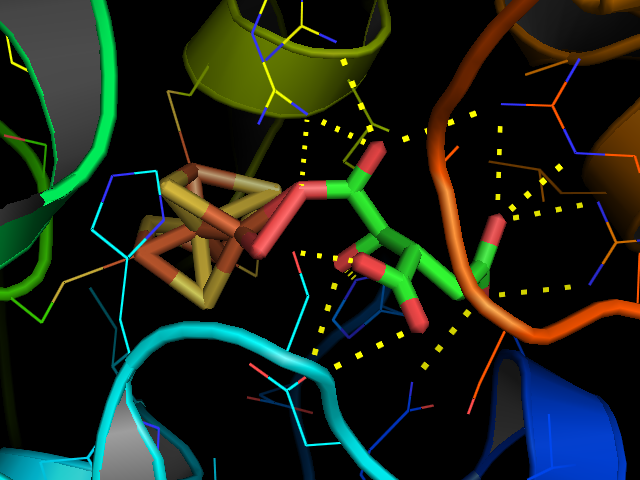|
3-Isopropylmalate Dehydratase
3-Isopropylmalate dehydratase () is an aconitase homologue, which catalyses the isomerisation of 2-isopropylmalate to 3-isopropylmalate, via dehydration, in the biosynthesis of leucine Leucine (symbol Leu or L) is an essential amino acid that is used in the biosynthesis of proteins. Leucine is an α-amino acid, meaning it contains an α-amino group (which is in the protonated −NH3+ form under biological conditions), an α- ca .... References External links * {{enzyme-stub Lyases ... [...More Info...] [...Related Items...] OR: [Wikipedia] [Google] [Baidu] |
Aconitase
Aconitase (aconitate hydratase; ) is an enzyme that catalyses the stereo-specific isomerization of citrate to isocitrate via ''cis''- aconitate in the tricarboxylic acid cycle, a non-redox-active process. Image:Citrate wpmp.png, Image:Cis-Aconitate wpmp.png, Image:isocitric acid.svg, Structure Aconitase, displayed in the structures in the right margin of this page, has two slightly different structures, depending on whether it is activated or inactivated. In the inactive form, its structure is divided into four domains. Counting from the N-terminus, only the first three of these domains are involved in close interactions with the Fe-4Scluster, but the active site consists of residues from all four domains, including the larger C-terminal domain. The Fe-S cluster and a anion also reside in the active site. When the enzyme is activated, it gains an additional iron atom, creating a Fe-4Scluster. However, the structure of the rest of the enzyme is nearly unchanged; the c ... [...More Info...] [...Related Items...] OR: [Wikipedia] [Google] [Baidu] |
Isopropylmalate
Isopropylmalic acid (isopropylmalate) is an intermediate in the biosynthesis of leucine, synthesized from oxoisovalerate by 2-isopropylmalate synthase In enzymology, a 2-isopropylmalate synthase () is an enzyme that catalyzes the chemical reaction :acetyl-CoA + 3-methyl-2-oxobutanoate + H2O \rightleftharpoons (2S)-2-isopropylmalate + CoA The three substrates of this enzyme are acetyl-CoA, ... and converted into isopropyl-3-oxosuccinate by 3-isopropylmalate dehydrogenase. Two isomers are important, the 2- and 3-isopropyl derivatives, and these are interconverted by isopropylmalate dehydratase. References {{Pharmacy-stub Dicarboxylic acids Alpha hydroxy acids Isopropyl compounds ... [...More Info...] [...Related Items...] OR: [Wikipedia] [Google] [Baidu] |
Leucine
Leucine (symbol Leu or L) is an essential amino acid that is used in the biosynthesis of proteins. Leucine is an α-amino acid, meaning it contains an α-amino group (which is in the protonated −NH3+ form under biological conditions), an α- carboxylic acid group (which is in the deprotonated −COO− form under biological conditions), and a side chain isobutyl group, making it a non-polar aliphatic amino acid. It is essential in humans, meaning the body cannot synthesize it: it must be obtained from the diet. Human dietary sources are foods that contain protein, such as meats, dairy products, soy products, and beans and other legumes. It is encoded by the codons UUA, UUG, CUU, CUC, CUA, and CUG. Like valine and isoleucine, leucine is a branched-chain amino acid. The primary metabolic end products of leucine metabolism are acetyl-CoA and acetoacetate; consequently, it is one of the two exclusively ketogenic amino acids, with lysine being the other. It is the most import ... [...More Info...] [...Related Items...] OR: [Wikipedia] [Google] [Baidu] |

